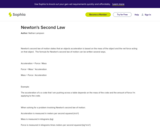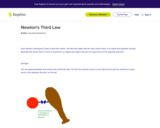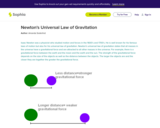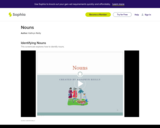
This lesson introduces Newton's Second Law and explains that force is equal to mass times acceleration. It is 1 of 3 in the series titled "Newton's Second Law."
- Subject:
- Science
- Material Type:
- Module
- Provider:
- Sophia Learning
- Date Added:
- 12/01/2023

This lesson introduces Newton's Second Law and explains that force is equal to mass times acceleration. It is 1 of 3 in the series titled "Newton's Second Law."

This lesson introduces Newton's Second Law and explains that force is equal to mass times acceleration. It is 2 of 3 in the series titled "Newton's Second Law."

Watch this introduction to Newton's Second Law of Motion. See example problems solved in an easy to understand format. [9:49]

This lesson will show that when a force is exerted on an object, an equal and opposite force is produced, as stated in Newton's Third Law. It is 1 of 3 in the series titled "Newton's Third Law."

This lesson will show that when a force is exerted on an object, an equal and opposite force is produced, as stated in Newton's Third Law. It is 2 of 3 in the series titled "Newton's Third Law."

In this narrated tutorial, see a graphical interpretation of Newton's third law of motion. [4:01]

A narrated screencast which explains the mathematical application of Newton's Third Law of Motion. [4:14]

This lesson will describe Newton's Universal Law of Gravitation. It is 1 of 3 in the series titled "Newton's Universal Law of Gravitation."

This lesson will describe Newton's Universal Law of Gravitation. It is 2 of 3 in the series titled "Newton's Universal Law of Gravitation."

Watch this narrated presentation, and take a different look at Newton's First Law of Motion, and find out what non-inertial reference frames are. [2:26]

This video tutorial introduces how to use concept maps and flowcharts to take notes for writing a paper or taking notes in class. It is 1 of 3 in the series titled "Note Taking: Concept Maps and Flowcharts." [7:20]

This lesson introduces how to take efficient notes while conducting research. [9:50]

This lesson introduces how to take efficient notes by condensing language. [7:40]

A screencast lesson [8:35] explaining how to determine which information is necessary and relevant when taking notes.

This video-based lesson [4:00] goes over noun clauses and how they can be used. It is 1 of 2 in the series titled "Noun Clauses." Includes a short quiz. L.9-10.1b Phrases/Clauses

This lesson introduces nouns and how they are used. [3:01]

This lesson will illustrate the unique characteristics of oceans and oceanic life. It is 4 of 4 in the series titled "Oceans."

Notes demonstrating how to correctly write and punctuate a quote when part of the quote has been removed and replaced with an ellipsis. Notes can be read and/or listened to and examples are provided.

This video lesson goes over how to alter a quotation by removing word or lines. It is 1 of 4 in the series titled "Omitting Words from Quotations." [5:17]

This presentation highlights the eleven organ systems of the body, giving a brief overview of their functions. [9:24]